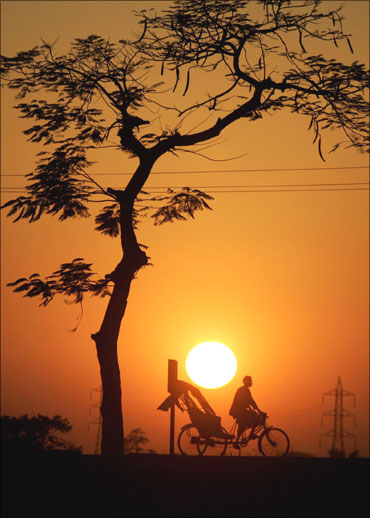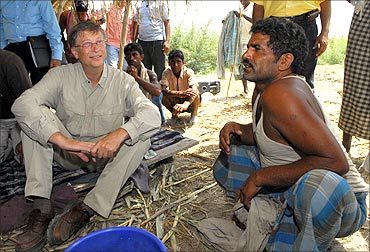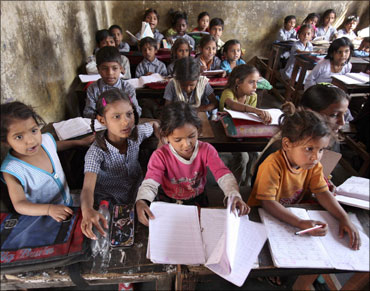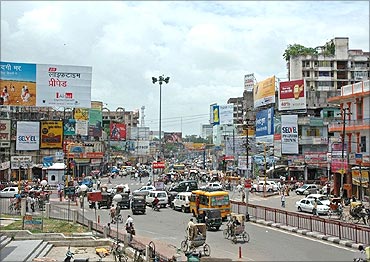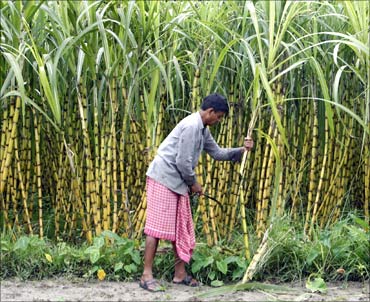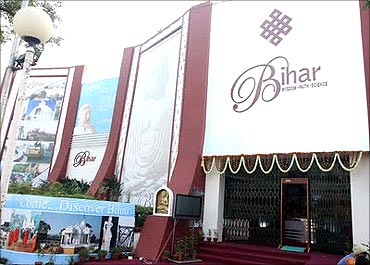 | « Back to article | Print this article |
Dark patches mar Bihar's growth story
There has been a wave of development works in Bihar changing the face of a poor and backward region and fast-tracking it to growth.
Noticeably there have been a slew of policy measures that have been in operation slated to bring benefit to communities including Antyodaya, Annapurna, Vikas Mitra, Maha Dalit Poshak Yojna, and Dashrath Manjhi Kaushal Development Scheme.
However, if one looks closer, this wave of development is not uniformly sweeping over the state. There are less visible aspects of the state's society and polity is which this wave bypasses.
There are swathes of the state in the eastern region where people live in constant fear and threat of floods. There are numerous rivers criss-crossing the area including Burhi Gandak, Kamla, and the dreaded Kosi.
Click NEXT to read on . . .
Dark patches mar Bihar's growth story
Then we do know that famine has wreaked havoc across the state over successive years following drought.
What does all this imply for those who are poor, living below the poverty line? How food secure are they?
It is actually quite heart-wrenching. For anyone who has cared to visit these areas during the flood fury which strikes this part of Bihar with alarming regularity, entire villages are displaced, people seek higher ground clutching on to food provisions which are dry like sattu, made of chick peas.
During floods, they live with little or no access to basic services, salvaging their meagre belongings. They watch their fields inundated, their homes destroyed, their cattle washed away. They are at times driven to eat snails and crab to survive.
Click NEXT to read on . . .
Dark patches mar Bihar's growth story
Instances of people dying of hunger from these regions at times reach the Human Rights Commission. However, what is critical is to examine the reasons behind these deaths.
Many of those displaced are poor landless peasants, who work as agricultural labour on other people's farms.
When the area gets flooded, the likelihood of earning a basic livelihood shrinks, extends to beyond what he has a provision for. They are then reduced to begging for survival.
Click NEXT to read on . . .
Dark patches mar Bihar's growth story
What one needs to remember that many of these people live on the brink even in normal times? They do not have any land, nor any shelter.
There would be countless such cases, some which are reported, many more probably which are not. The point is that what is the government doing to meet the situation.
After all, it has arisen from a set of circumstances, both natural and manmade, which needs to be addressed. Does all this not reflect lacunae in policy, in action steps to mitigate and minimise such lapses?
Click NEXT to read on . . .
Dark patches mar Bihar's growth story
Hunger deaths do get reported periodically. And during the last year, newspaper offices were flooded with the news of such cases from famine-affected districts in Jahanabad, Gaya, Nalanda, Begusarai, and Araria.
But again, such information can lose its relevance or be underplayed if the government does not respond. Or lobby groups do not take it up.
The condition of small farmers dependent on a rain-fed agricultural economy has been pathetic for decades now.
Click NEXT to read on . . .
Dark patches mar Bihar's growth story
Environmental changes, lack of irrigation facilities, poor supply of electricity along with rising input costs; these are the ingredients of agriculture in crises, in many parts of the country.
In Bihar especially prone to flood and famine, the situation gets exacerbated. Productivity is low. Perhaps this is the reason that food capita has decreased; people just do not have the resources to access adequate food.
Deaths from hunger could be easily avoided if the government intervenes in time. Let us remember that this is a state, prone to natural calamities, which rock the foundation of its society, especially those precariously balanced on the edge.
Click NEXT to read on . . .
Dark patches mar Bihar's growth story
Bihar has a rich and glorious history. It also has a complex tapestry of social equations; its political economy reflects this with caste and region playing a crucial role in the running of the state.
Yes, the Armageddon of development is sweeping through, driven by a renewed mandate for the present government. This can be a great equaliser and is the card that Bihar Chief Minister Nitish Kumar has played prior to the elections and is banking on now.
All this is fine, but what needs focused attention is how to bring this development to those who have lived on the margins. Food security is an excellent measure to establish how the state policies cater to the needs of the poor.
Click NEXT to read on . . .
Dark patches mar Bihar's growth story
The moot question is whether these are pro-people, pro-poor and take into account the huge sections of population who continue to be assaulted by natural disasters and an errant monsoon.
The government in power should not lull itself to believe that sound and fury and even some action is enough to justify the mandate, which has given it a second innings in office.
The Charkha Development Communication Network feels that unless the policies and programmes are so conceived and implemented as to reach the person who has been standing on the margins for decades now, the Bihar growth story will be under a cloud. - ANI


